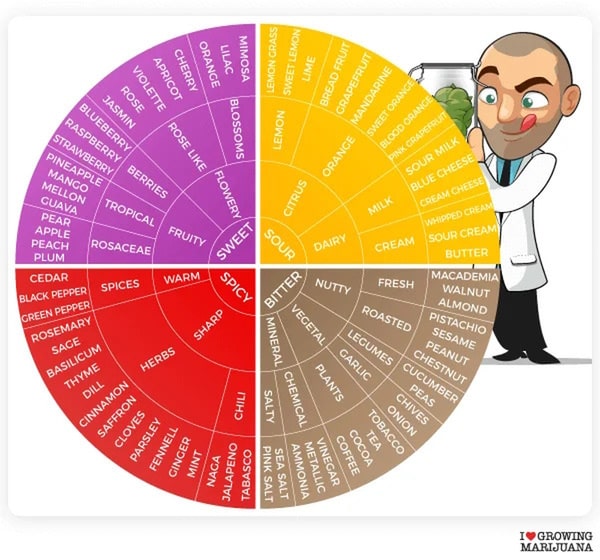
Terpene charts are an invaluable resource for cannabis growers and smokers alike, providing essential information about the diverse range of aromatic compounds found in various strains. In this article, we’ll delve into the intricate and essential realm of terpenes to aid you in comprehending their significance.
We’ll begin by exploring what terpenes are and how they contribute to the unique characteristics of different cannabis varieties. Next, we’ll discuss methods for identifying specific terpenes through scent profiles and other indicators. From there, we will examine some of the numerous benefits associated with these fascinating compounds – from enhancing flavor profiles to promoting overall wellness.
Finally, we will introduce you to some common cannabis terpenes that every enthusiast should be familiar with and provide guidance on creating your own comprehensive terpene chart. By gaining a deeper appreciation for these naturally occurring substances, you can elevate your cannabis experience while also expanding your knowledge within this ever-evolving field.
Table of Contents:
- Understanding Terpenes
1. Understanding Terpenes
Terpenes, organic compounds found in various plants such as cannabis, are responsible for the unique aroma and flavor of each strain. In the world of cannabis cultivation and consumption, terpenes play a crucial role in differentiating strains and enhancing the overall experience for growers and smokers alike. This section will delve into the basics of terpenes to help you better understand their importance in your cannabis journey.
What Are Terpenes?
Terpenes are naturally occurring volatile compounds produced by many plants as part of their defense mechanisms against herbivores or pathogens or to attract pollinators. They consist of carbon-based molecules arranged in various configurations that determine each terpene’s unique scent profile.
The Role of Terpenes in Cannabis Plants
In addition to giving cannabis its signature smell, terpenes also contribute significantly to each strain’s effects on users’ minds and bodies. The combination of cannabinoids (such as THC and CBD) with specific terpene profiles creates what is known as “the entourage effect”, which enhances the therapeutic properties while reducing any adverse side effects.
- Aroma: Each strain has a distinctive fragrance due to its unique blend of terpenoids; this can range from fruity scents like citrus or berry notes, earthy tones such as pine or woodsy aromas.
- Taste: Similar to how they affect aroma, these compounds also influence taste buds when smoking or ingesting marijuana products; some examples include spicy flavors reminiscent of cloves or peppermint undertones found within certain strains.
- Effects: Terpenes can impact the overall experience by modulating how cannabinoids interact with our body’s endocannabinoid system, which regulates various physiological processes like mood, appetite, and pain perception.
In summary, understanding terpenes is essential for cannabis growers and smokers alike. By learning about these compounds’ roles in aroma, taste, and effects on users’ experiences with different strains of marijuana plants – you’ll be better equipped to choose the right strain for your needs or even create new hybrid strains that cater specifically to your preferences.
Understanding terpenes is essential to properly cultivating and identifying cannabis. Identifying terpenes requires a comprehensive knowledge of the different types, their effects on the plant, and how they interact with each other.
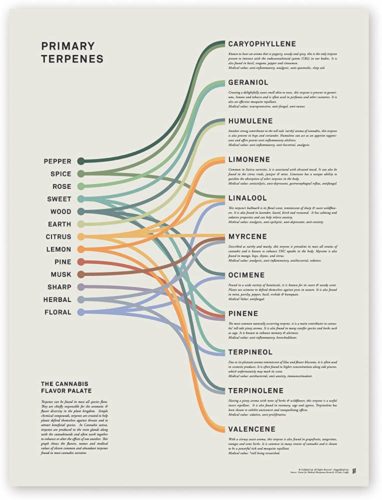
2. Identifying Terpenes
Being able to identify different terpene profiles in cannabis plants is essential for both growers and smokers alike. It helps you choose the right strains based on your desired effects, flavors, and aromas. In this section, we will discuss some tips and techniques to help you recognize various terpenes present in cannabis.
Aroma & Flavor
The most straightforward way to identify terpenes is by their aroma and flavor. Every terpene has its own distinct odor, which all combine to form the scent of the plant. For example, myrcene gives off an earthy aroma while limonene has a citrus scent. By familiarizing yourself with these scents, you can easily detect specific terpenes in any given strain.
Tips for Aroma Identification:
- Gently squeeze or rub a bud between your fingers to release its natural oils.
- Inhale deeply through your nose close enough without touching it directly.
- Note down any distinct smells such as fruity, floral or spicy undertones.
Laboratory Testing
While using our senses can be helpful when identifying certain terpenes at home, lab testing provides more accurate results about their presence and concentration levels within each strain. Many reputable labs offer comprehensive cannabinoid and terpene analysis services, giving detailed information on all compounds found in your sample.
Tips for Lab Testing:
- Select a reliable laboratory with experience in cannabis testing.
- Ensure the lab uses validated methods and adheres to industry standards.
- Request a detailed report with terpene concentrations expressed in percentages or milligrams per gram (mg/g).
Terpene Charts & Guides
A terpene chart is an excellent tool for identifying various terpenes found in cannabis plants. These charts typically display each terpene’s name, aroma, flavor profile, and potential effects. By referring to such guides regularly, you can quickly recognize specific terpenes present in your favorite strains. There are numerous online resources available that provide comprehensive information on different types of cannabis terpenes.
Tips for Using Terpene Charts:
- Locate a dependable source that supplies up-to-date info regarding the diverse cannabis terpenes.
- Print out or bookmark these charts for easy reference during your next strain selection process.
- Familiarize yourself with common aromas and flavors associated with each listed compound.
Growers can gain insight into the diverse terpenes and their impacts, allowing them to pinpoint those that are most suitable for their requirements. Now, let us investigate the manifold advantages that these molecules possess.

3. Benefits of Terpenes
In recent years, terpenes have gained significant attention for their potential benefits in cannabis plants. Terpenes are key to providing unique aromas and flavors, as well as enhancing the therapeutic effects of cannabinoids like THC and CBD through the entourage effect.
3.1 Synergistic Effects with Cannabinoids
The interaction between terpenes and cannabinoids is known as the entourage effect. This phenomenon suggests that these compounds work together synergistically to enhance each other’s beneficial properties while mitigating some adverse side effects such as anxiety or paranoia associated with high-THC strains.
Examples:
- Linalool: Known for its calming properties, linalool can help counteract the anxiety-inducing effects of THC.
- Caryophyllene: A potent anti-inflammatory agent, caryophyllene may boost CBD’s ability to reduce pain and inflammation.
- Limonene: By elevating mood and reducing stress levels, limonene can potentially improve the overall experience when consuming cannabis products rich in both THC and CBD.
3.2 Health Benefits Beyond Cannabis Use
Beyond their interactions with cannabinoids, terpenes are believed to offer various health benefits on their own due to their presence in numerous plant species used for medicinal purposes throughout history. Some examples include essential oils derived from lavender (rich in linalool) or black pepper (high concentrations of caryophyllene).
Potential Therapeutic Properties:
- Anti-inflammatory: Terpenes like caryophyllene and pinene have been shown to possess anti-inflammatory properties, which may help in managing conditions such as arthritis or inflammatory bowel disease.
- Antioxidant: Some terpenes, including limonene and myrcene, exhibit antioxidant effects that can protect cells from damage caused by free radicals.
- Anxiolytic & Antidepressant: Linalool and limonene are known for their potential anxiolytic (anxiety-reducing) and antidepressant effects. These terpenes could be utilized to create novel remedies for psychological conditions.
In conclusion, the benefits of terpenes extend beyond just enhancing the aroma and flavor profiles of cannabis plants. Their synergistic interactions with cannabinoids offer a more balanced experience when consuming cannabis products while also providing various health benefits on their own. To grasp the full potential of terpenes, it is vital for both growers and users to comprehend their influence on plant quality.
Terpenes can offer a wealth of advantages, including enhancing the taste and scent of cannabis. Moving on, let’s take a look at some common cannabis terpenes found in marijuana strains.
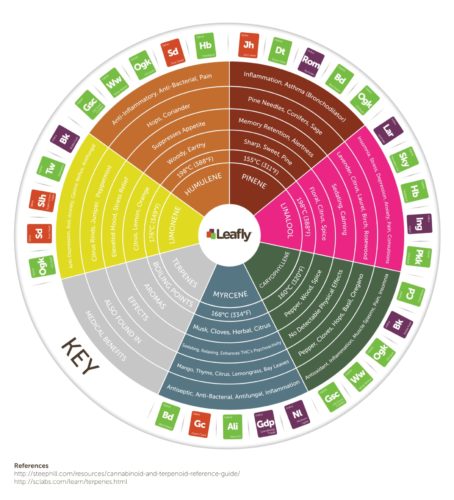
4. Common Cannabis Terpenes
In this section, we will explore the various terpenes present in cannabis plants and how they may affect users. Understanding these terpenes can help you make informed decisions when selecting strains for specific purposes or desired experiences.
a) Myrcene
Myrcene is one of the most abundant terpenes in cannabis, contributing to its earthy and musky aroma. It is also found in other plants such as hops, thyme, and lemongrass. Some studies suggest that myrcene may have anti-inflammatory and analgesic properties, making it potentially beneficial for pain relief.
b) Limonene
Limonene is a citrusy-smelling terpene commonly found in citrus fruits like oranges, lemons, and limes. In addition to providing a refreshing scent to certain cannabis strains, limonene has been studied for its potential antidepressant-like effects. This makes it an interesting option for those seeking mood-enhancing benefits from their cannabis consumption.
c) Linalool
Linalool, known for its floral aroma reminiscent of lavender flowers, is another prevalent terpene present in various cannabis strains. Research suggests that linalool may possess anxiolytic (anti-anxiety) and anti-inflammatory properties, making it a potentially useful terpene for those seeking stress relief and relaxation.
d) Caryophyllene
Caryophyllene, characterized by its spicy, peppery aroma, is another common cannabis terpene. It is unique among terpenes because it can also act as a cannabinoid, binding to the CB2 receptors in our endocannabinoid system. This interaction may contribute to caryophyllene’s potential anti-inflammatory and analgesic effects.
e) Pinene
Pinene, as the name suggests, has a distinct pine-like scent that can be found in many plants besides cannabis, such as pine trees and rosemary. Two different varieties of pinene exist, alpha and beta-pinene, which have been explored for their potential to open up airways and potentially benefit those with respiratory conditions like asthma. Both have been studied for their potential bronchodilatory (airway-opening) effects which could benefit users with respiratory issues like asthma.
In addition to these five common terpenes, there are numerous other compounds present in various strains of cannabis that contribute to their unique profiles. By understanding these components better through resources like this article or creating your own terpene chart, you’ll be well-equipped to make informed decisions when selecting strains based on desired experiences or therapeutic benefits.
By analyzing cannabis terpenes, growers can craft a distinctive flavor profile for their product. Constructing a thorough terpene graph is an effective way to gain insight into these molecules and comprehend how they cooperate.
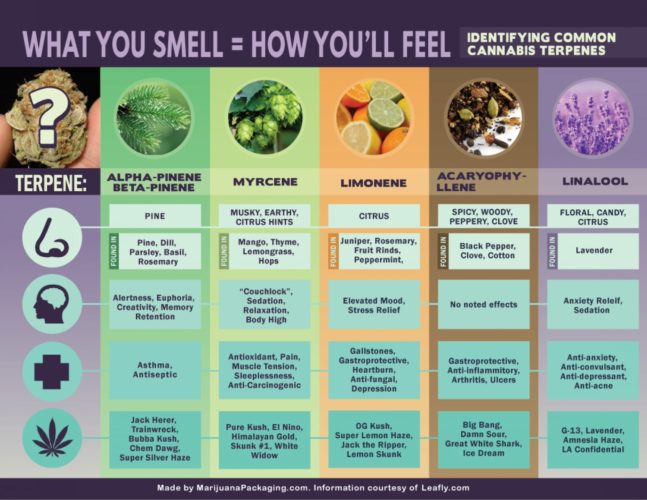
5. Creating a Terpene Chart
As you learn more about terpenes and their various benefits, it can be helpful to create a comprehensive terpene chart for easy reference. This chart will allow you to track your favorite terpene profiles in cannabis plants and help you make informed decisions when selecting strains or products based on their unique characteristics.
A. Gathering Information
To begin creating your terpene chart, start by gathering information on the most common terpenes found in cannabis plants. You can find this information through reputable sources such as scientific studies, articles from National Center for Biotechnology Information (NCBI), or websites dedicated to cannabis education like GreenBudGuru.com. Be sure to note down the names of each terpene along with its potential effects and benefits.
B. Organizing Your Chart
Once you have gathered enough information on different types of terpenes, it’s time to organize your data into an easily accessible format. Think about utilizing a spreadsheet program such as Microsoft Excel or Google Sheets to arrange your data.
- Create columns labeled “Terpene Name,” “Aroma,” “Effects,” and “Benefits.”
- In each row under these headings, input the corresponding details for each specific type of cannabis plant that contains high levels of particular terpenes.
- Add additional rows as needed when new data becomes available or if you want to include less-commonly known cannabinoids in your list.
C. Updating Your Terpene Chart
To ensure accuracy, regularly review scientific research and news reports on terpene profiles in cannabis plants; additionally, join online forums to connect with others who share their knowledge of different strains. Stay informed by regularly checking for updates on scientific research or news articles related to terpene profiles in cannabis plants. You can also join online forums or communities where like-minded individuals share their knowledge and experiences with different strains.
D. Using Your Terpene Chart
Your completed terpene chart will serve as a valuable resource when selecting strains based on specific effects, aromas, or benefits that appeal most to you. For example, if you’re looking for a strain known for its relaxing properties, consult your chart and look for high levels of myrcene. On the other hand, if you want an uplifting experience with increased focus and creativity, search for strains rich in limonene.
In conclusion,
Conclusion
In conclusion, terpene charts are a great tool for cannabis growers and smokers to understand the complex chemistry of their plants. By studying these charts and learning about each individual terpene’s benefits, you can gain an understanding of how different strains may affect your body differently. Creating a personal terpene chart is also helpful in tracking which strain works best for you so that you get the most out of your cannabis experience. With this knowledge at hand, it’s easier than ever to customize your own unique blend using various types of weed with differing levels of potency as indicated by its respective terpene chart.
Discover the secrets of growing weed with GreenBudGuru.com‘s comprehensive terpene chart and become an expert cannabis cultivator today! Unlock the power of plant chemistry to maximize your yield and potency for optimal results.
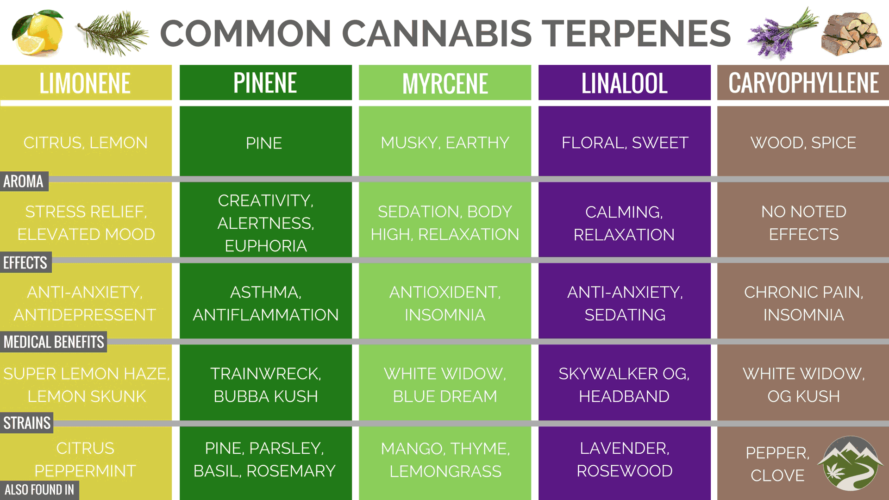
Originally posted 2023-04-06 12:20:00.


 James Alexander
James Alexander